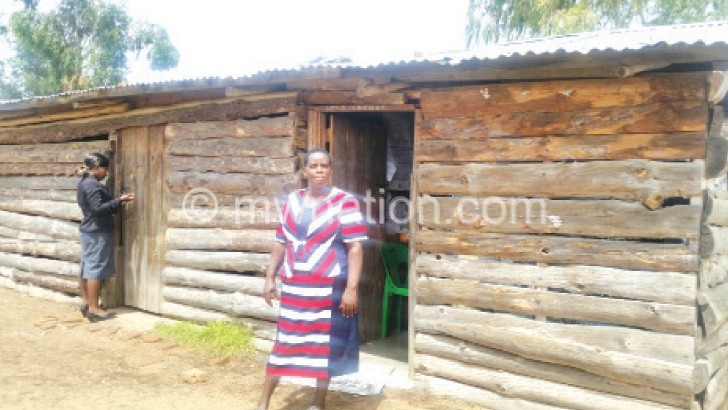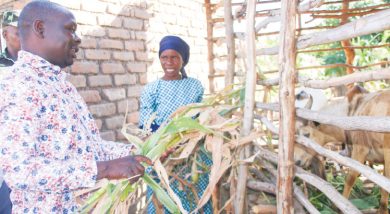Learning dangerously
Pupils at Chibanja Primary School in Mzuzu face the wrath of nature. Locals call the disaster-prone leaning institution ‘madimba’, as it lies in a marsh where they used to grow sugar cane, potatoes and vegetables.
Now, residents of the township, which overlooks Mzuzu’s neglected airport, worry about the safety of their children who learn in ramshackle classrooms that are precariously made of residual timber and falling apart.
The school, forked between two streams, sits in a flood-prone wetland where danger lurks every day.
Constructors tried to minimise the risks by reinforcing the ground with wood chippings and sawdust, but disasters have proved their efforts meaningless every year. Just last month, a hailstorm blew the off roof of a classroom block.

The locals remember that the leaky school temporarily shut down when flush floods, which rendered almost 7 000 city residents homeless in 2016, destroyed toilets, access roads and school property.
This is depressing to head teacher Grace Simkonda, her staff and learners.
“Our major concern is that the school blocks cannot withstand chronic disaster,” she says.
The school comprises two blocks crudely walled by timber residues known as vigwagwa. They house four classrooms for lower classes, Simkonda’s office and a staffroom.
Away from this makeshift affair are two red-brick blocks for the upper classes.
“The wooden blocks are on their last legs. It’s a death trap for both learners and teachers. It’s not safe for teaching and learning,” says Simkonda.
The decrepit buildings also expose learners and teachers to harsh conditions when it is rainy and chilly in the leafy city. In times of downpours, all classrooms leak, disrupting classes in session.
“We are not safe here,” says the head teacher.
The school was established to save children in Chibanja from walking long distances to Chibavi Primary School and being crashed by speeding vehicles on M1 on their way to CCAP Primary School less about a kilometre away.
We interviewed parents who say they fear the classrooms may injure and kill their children if the crumbling classrooms collapse.
‘Madimba’ was lucky that no one suffered an injury during the January disaster.
But nine pupils at Kazando Primary School in Mchengautuba Township, on the northern edge of the wetland, sustained injuries when hailstorms blew off a school block roof.
According to Kazando head teacher Ruth Yiteta, some pupils were admitted to Mzuzu Central Hospital and others were treated as outpatients.
“Tragedy struck while classes were underway. Everything was soaked that on rainy day,” she recalls.
The bricks of the battered buildings have been built with mud. As disasters are becoming recurrent, teachers asked for resilient structures reinforced by cement.
Currently, the school is temporarily operating in “borrowed incomplete structures”. At the new site, about a kilometre away, there are no toilets and safe water.
This puts the pupils at risk of waterborne diseases, including cholera which has affected 450 people in 12 districts, including Karonga, Nkhata Bay and Likoma in the North.
The neglected school personifies the nationwide shortage of classrooms to the extent that a teacher handles up to 100 pupils.
“Shortage of safe classrooms in primary schools is a prevalent situation in the city. We have 41 primary schools, but most of these require proper infrastructure,” says Mzuzu district education manager Amon Chavula.
He reckons population and enrolment rates are rising faster than the number of new classrooms taking shape.
Chibanja Primary School, which serves a bulging population estimated at 10 000 households, was initiated by city residents to decongest Chibavi which had about 4 000 pupils.
“Government provided structures under the Local Development Fund, but that is not enough,” says Chavula.
In 2011, Unicef reported that the country has a shortfall of 30 000 classrooms, resulting in a teacher-to-pupil ratio of 1:88.
With only about 2 000 classrooms being constructed every year, the United Nations agency projected that it would take the country at least 15 years to meet the demand.
Education experts described this as one of the aftershocks of the hurried introduction of free primary education in 1994.
The policy shift has increased the number of children accessing primary school, but education standards have declined due to shortage of infrastructure, teachers as well as learning and teaching materials,.
Enrolment increased by 16 percent between 2008 and 2013.
Church and Society executive director Moses Mkandawire is worried that shortage of classrooms in both urban and rural schools continues to deprive pupils of an enabling learning environment.
“We can’t allow our pupils to be learning in that kind of environment right in the city. This shows we are not serious as a nation,” he says.
The activist asks government to invest more funds in providing a safe learning environment for pupils.
But Ministry of Education, Science and Technology spokesperson Lindiwe Chide says construction of school facilities is the duty of councils in line with decentralisation.
But Mzuzu City Council chief executive officer McCloud Kadammanja said the ministry is still retaining the development budgets despite the highly publicised decentralisation.
“They should not run away,” he said. “It is still their duty to fund construction of school infrastructure because they are yet to devolve this budget,” he says.
As finger-pointing and blame games continue, Mkandawire urges councils across the country need to utilise Constituency on the Development Fund (CDF) and the Local Development Fund (LDF) to ensure every Malawian child is learning in a safe space.
As children take notes at Chibanja, it is clear they are dying for education—but they need no die because of official negligence and indifference their classrooms exemplify. n





